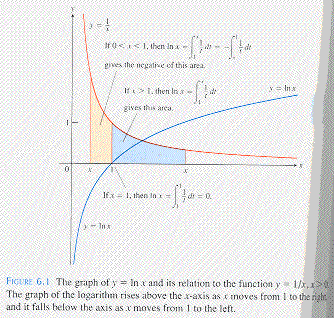Definition of the Natural Logarithm Function
Laws for Logarithms
The Range
The Derivative Logarithmic
Differentiation
The Integral of 1/u
Integrals of Tan x/Cot x
Derivative of loga u
Integrals Involving loga x
Definition of the Natural Logarithmic Function
![]()

From the graph, we see that the function ![]() is not defined for
is not defined for ![]() .
.
By the Fundamental Theorem of Calculus, Part 1,
![]()
Generalizing by the Chain Rule, we get
The Derivative
![]() (1)
(1)
where ![]() is a differentiable
function of
is a differentiable
function of ![]() .
.
See Example 1, page 459.
The usual Laws for Logarithms hold:
For any numbers ![]() and
and ![]() ,
,
i]
![]()
ii]
![]()
iii]
![]()
The Range
![]() and
and
![]()
The Integral of ![]()
Equation (1) gives the corresponding antiderivative formula
![]() (2)
(2)
which is true whether ![]() is positive or negative, but not zero.
is positive or negative, but not zero.
Notice that this result fills in the exception in the Power Rule formula
![]() .
.
When ![]() ,
,
![]() ,
,
which is just the integrand in formula (2).
See Example 2 - 3, pages 461 - 462.
The Integrals of the Tangent and Cotangent
Using the substitution
![]() ,
,
![]() ,
,
we can write
![]()
![]() .
.
A similar derivation works for ![]() .
.
Generalizing, when ![]() is a differentiable
function
is a differentiable
function
![]() (3)
(3)
![]() (4)
(4)
See Example 4, page 462.
Logarithmic Differentiation
If we want to differentiate a positive function consisting of products, quotients,
and powers, often a good way is to first take the logarithm of both sides
- using the laws of logarithms (i) - (iii), this step simplifies the function
-
and then differentiating.
See Example 5, page 463
Derivative of![]()
We use the change of base formula to write
 (5)
(5)
See Example 6, page 463.
Integrals Involving![]()
First, convert the base ![]() logarithms
to natural logarithms, using the change of base formula.
logarithms
to natural logarithms, using the change of base formula.
See Example 7, page 464.
next
Exponential
Functions
Top